ARTS&SCIENCE is a brand owned by Sonya Park, the director of the Hobonichi Planner. This year, all of the ARTS&SCIENCE staff are using the Hobonichi Planner. We were curious to see how they were using their techos, so Ms. Fujimura, our contact with ARTS&SCIENCE, agreed to show us hers. What was most interesting was seeing her use for the techo change over time. At first she only used it for writing plans, but the more she used it, the more it took on journal entries, sketches, stamps, and pasted papers. Come take a look at her fun-looking techo!
Everyone’s Using One This Year
- Hobonichi
- We heard that everyone at ARTS&SCIENCE is using the Hobonichi Planner this year.
- Fujimura
- Yes, since this year [2013] is its very first edition, everyone got a copy and has been using it. There’s a lot of things we noticed upon actually using it.
- Hobonichi
- What has everyone been using it for? Work or personal use?
- Fujimura
- It looks like everyone’s using it differently, for whatever they like. I use it for both work and personal use, but our store staff, for example, can’t write things down during work, so they use it for personal things. And some of our male staff use it as just a memo pad.
- Hobonichi
- Does Sonya and everyone talk about how they’re using their techos?
- Fujimura
- Definitely. We talk about ways we can use certain parts of it, and think up new kinds of pages.
- Hobonichi
- So do you think things you’ve all talked about together will make it into the 2014 Hobonichi Planner?
- Fujimura
- Yes, some of what we came up with will make it into the 2014 version.
- Hobonichi
- Now then, shall we take a look at your planner?
- Fujimura
- Sure.
Carrying Pens and Sticky Notes
- Fujimura
- Here’s my Hobonichi Planner. I chose the black cover.
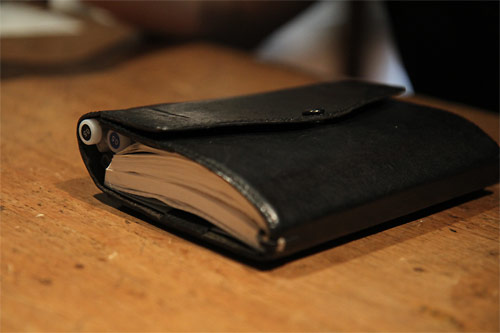
- Hobonichi
- Ah, I see. So that’s how you store your pens, squeezed in on the button side.
- Fujimura
- Yeah, it’s a bit tight. (laughs) I usually carry around three pens with me.
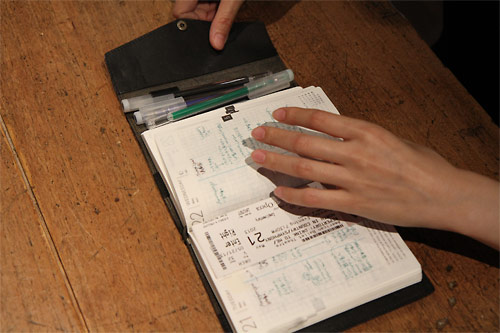
- Hobonichi
- So if you’ve got three ball-point pens, does that mean you don’t really erase anything?
- Fujimura
- Well, this pen is erasable.
- Hobonichi
- Oh, I see. That’s really convenient.
- Fujimura
- It really is. And here’s where I keep my sticky notes.
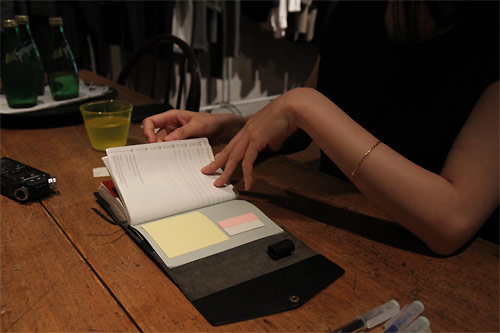
- Hobonichi
- Oh, in the last page.
- Fujimura
- Yeah, it’s easy to open, so I store them here.
Dividing Pages With Light Blue Ink
- Hobonichi
- Could we take a look at the inside?
- Fujimura
- This is basically what it looks like.
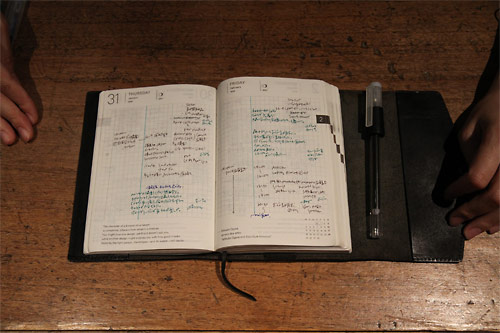
- Hobonichi
- I see you’re splitting each page into two parts with a light blue line.
- Fujimura
- I write out the company schedule on the left side, and personal things on the right. I’m in charge of checking things over with Sonya and other staff, so I need to have a basic idea of schedules.
- Hobonichi
- Do you usually write in these three colors, black, blue, and green?
- Fujimura
- Yes. Black is work-related, blue is personal plans, and green is for other things, like when I write little journal entries. Also, I write my daily to-do list at the top right of every page, and schedules on the bottom right. I’ll fill in extra space with journal entries or notes of what I ate that day. So this is what it looks like most of the time.
Changing What I Use it For
- Fujimura
- I didn’t actually know at first how I was going to use a page per day. I used to use a weekly planner by another company, and I’d only ever written my plans in it. I kept it simple.
- Hobonichi
- Oh, really?
- Fujimura
- For example, I started using this when the pages started last December, but at first I only ever wrote my plans in it, like I did with my old planner.
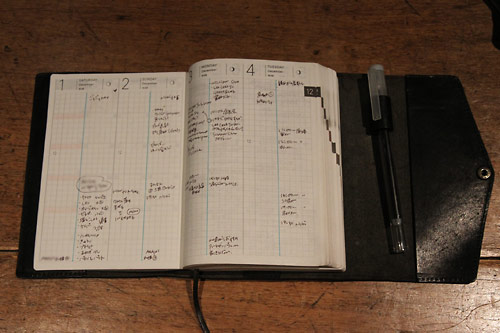
- Hobonichi
- Oh, you’re right. These pages have nothing but schedules in it. And the writing is in your work-designated black ink.
- Fujimura
- Yeah, nothing but work schedules. But I slowly started writing personal notes in it like a diary.
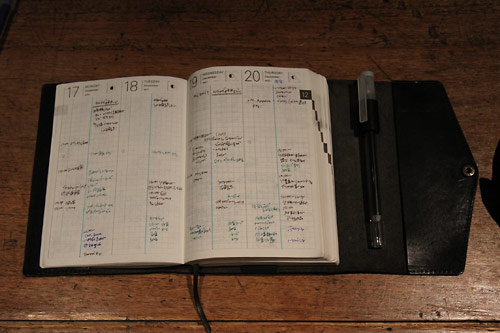
- Hobonichi
- I can see that. The next page starts having the green ink you mentioned.
- Fujimura
- And I only ever wrote in it at first, but then I started getting a little bored with it. So I started putting little sketches in my pages. Here’s one where I made gyoza, and here’s a scene I saw.
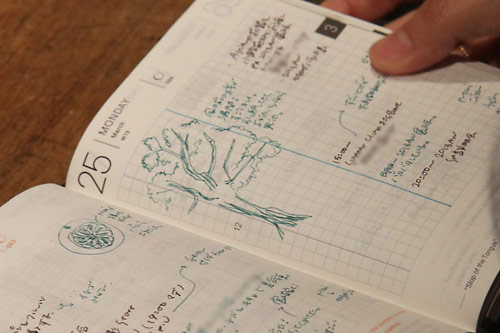
- Hobonichi
- Sure enough. These pages are in March, and your pages are getting a little more lively with the drawings.
- Fujimura
- Well, it’s almost all food-related... (laughs)
- Hobonichi
- Even though you started with nothing but work plans. (laughs)
- Fujimura
- I still write about work in it, but I’ve gradually started writing more personal things. On days when I don’t have many plans to write down, I’ll write what I ate that day, or I’ll fill the page with a stamp or two.
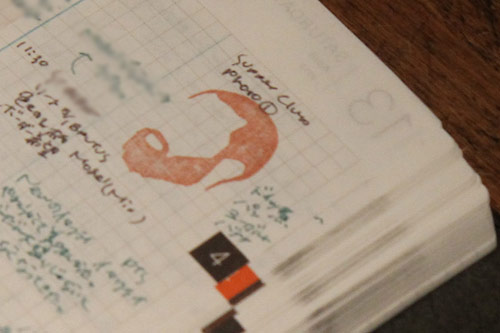
- Hobonichi
- It’s looking more and more fun.
- Fujimura
- And starting in May, I remembered how people paste things in their techos, so I started that, too.
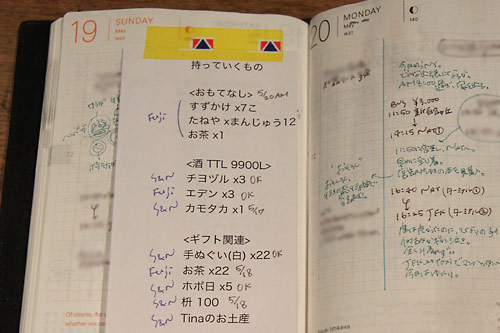
- Hobonichi
- That’s neat how your technique broadened like that. Is this some kind of list you taped to the page?
- Fujimura
- This is a list of souvenirs I brought on a business trip. I recorded brief outlines of what I did during the trip, and after I got home, I wrote them out properly. It helped me write out my trip report. And here I pasted a ticket to a ballet.
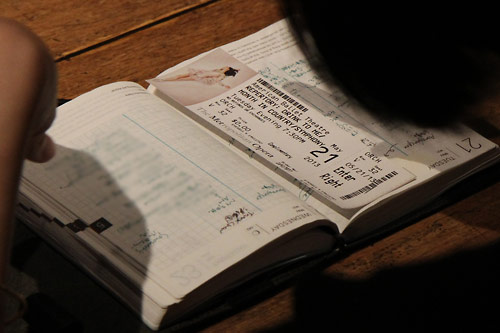
- Hobonichi
- How nice. And here’s some delicious-looking food.
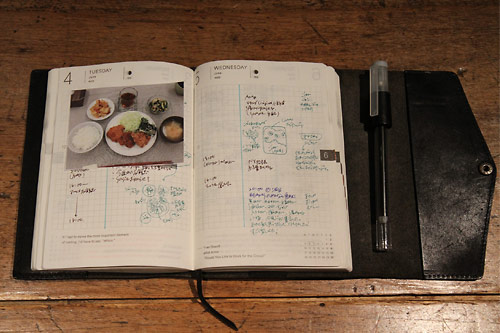
- Fujimura
- This is when I was treated to lunch at the Hobonichi office. (laughs) I took a picture of it when I visited the other day.
- Hobonichi
- Oh, I remember. (laughs) I had a feeling I’d seen it before.
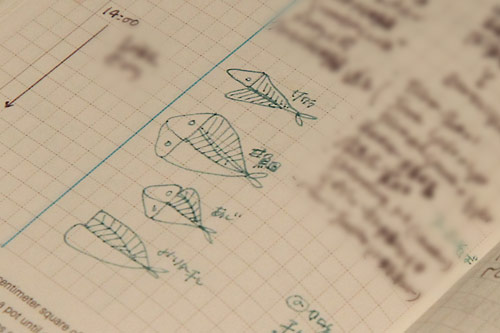
- Fujimura
- And on this page I drew out some dried fish I ate. Well, now my notes about what I ate are standing out more than all my work notes...
- Hobonichi
- No, it’s okay, this is really interesting. I like seeing your use for it broaden over time.
- Fujimura
- It’s so much fun noticing more ways to use the techo and switching up how I use it.
Recording Drinks in the Yearly Index
- Hobonichi
- How else are you using it outside of the daily pages?
- Fujimura
- In the yearly index pages, I write down the alcohol I drank that day.
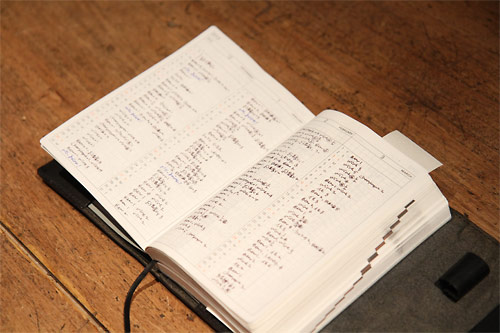
- Hobonichi
- Wow, now this is amazing. This is really interesting.
- Fujimura
- I was curious to see how much I drank over the course of a year, so I made it a habit to record it every day.
- Hobonichi
- And how do you use the extra note pages in the back?
- Fujimura
- I collect things like questions I’m often asked during interviews, such as information about what year each store had opened.
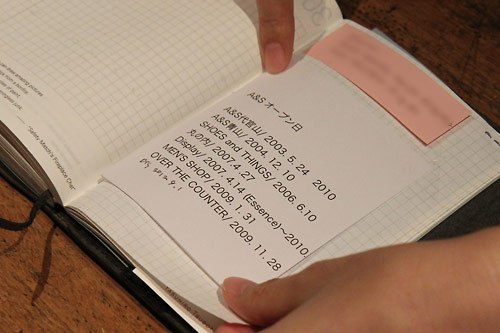
- Hobonichi
- I see. It must be convenient to have all this information handy in the back.
- Fujimura
- And in some note pages I’m making scrap pages to paste information. Nice restaurants, photos, letters I received, things like that.
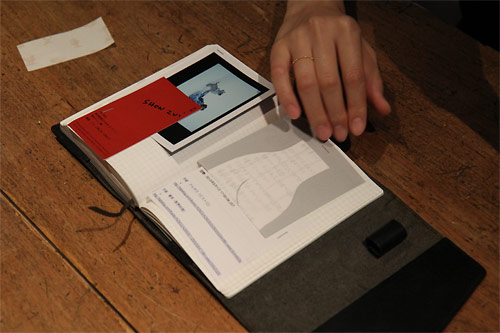
- Hobonichi
- That’s a nice way to use it. It’s incredible how you went from using it only for plans, and expanding to such a variety of usages like this.
- Fujimura
- Yeah, it all changed before I noticed. I started having more fun with it, and this is how it turned out.
I Want to Keep Information Together
- Hobonichi
- How do you like the Hobonichi Planner so far this year?
- Fujimura
- What I find most convenient about it is having everything in one book. The Hobonichi Planner is my first experience with a page-per-day planner, and I realized for the first time how convenient it is to be able to write down meeting minutes all in one place. (laughs) I don’t have to worry about remembering which notebook I wrote it in, or losing my notes. I want to keep all my information together.
- Hobonichi
- Do you ever read back through your techo?
- Fujimura
- I do. I often read back on jobs we have regularly. For example, we’ve got photography for the catalogs, and by writing down ideas and things we come up with on the spot, it’s good to be able to use those for next time. Like one note saying there weren’t enough small articles in the shot, so we should include some more in the next photo shoot.
- Hobonichi
- Yeah, writing all that down makes it easier to remember later on.
- Fujimura
- So, I think that’s about it.
- Hobonichi
- Thank you so much for sharing with us. It was very interesting.
- Fujimura
- Thank you. Although I’m still on the search for new kinds of uses.
- Hobonichi
- Oh, really? I hope we can catch up on your new discoveries some time.
- Fujimura
- Certainly.





















